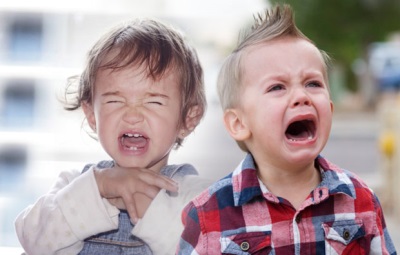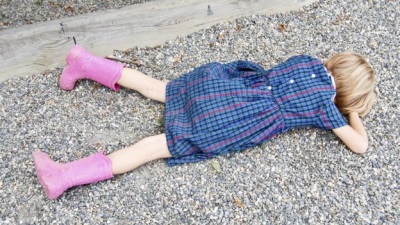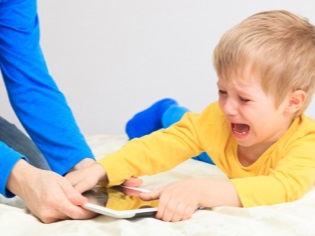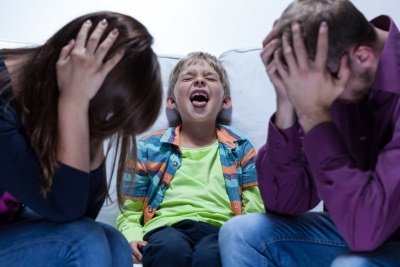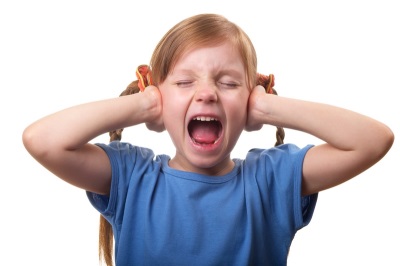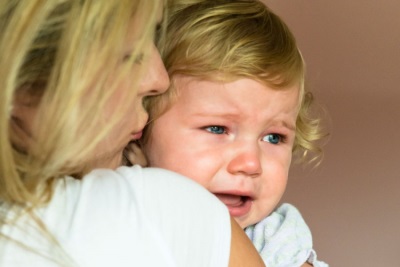How to cope with hysterics in a child? Effective advice of a psychologist
Hysterical child: he stomps his feet, screams, cries and does not want to hear anything. Or monotonously whines, whimpers and crooks. Every parent has ever encountered the same behavior of his child. But usually the problem is larger than it seems and affects 9 out of 10 families that have to raise a hysterical child. Yes, and hysterics themselves - not a one-time phenomenon, so they occur systematically. Moms and dads in confusion, they are angry, worried, do not know how to stop all this. What do adults do if a child has hysterics?
What is a child tantrum?
Tantrum is a special emotional state of extreme arousal. The child screams, sobs, falls to the floor, can beat against the walls or scratch his face. He is completely insensitive to the words and actions of others and practically does not feel pain. It is extremely difficult to stop. Such behavior frightens and puzzles parents, especially if, in their opinion, there were no specific reasons for such behavior. What have adults done wrong?
Hysteria, as a rule, although it develops rapidly, but like any process in our body, it proceeds in several stages. Even if it seems that everything started suddenly, believe me, the symptoms of the beginning “concert” were, and they need to be learned to recognize. Often the baby begins to sniffle, whimper, fall silent. This is the calm before the storm. If you respond in time, tantrums can be avoided. Sometimes for this purpose it is enough to gently embrace the kid offended by the whole world, to ask what so distressed him. If it's a broken toy, suggest fixing it together.
Some children for the prevention of hysteria enough to switch to another activity. Can't build a constructor? Do not cry, we will now paint, and then we will surely assemble a house or a locomotive from stubborn parts. If the precursors could not be discerned or the adults did not give them the proper importance, the hysteric itself begins.
- The first stage is voice. The child, trying to draw attention to himself, begins to whimper or immediately scream.
- The second stage is motor. It is characterized by excited active movements of the baby. He can start throwing toys, stomping, rolling on the floor. This is the most dangerous stage - the child can be injured.
- The third stage is residual. This is a kind of way out of the “pique” - a physically and morally tired child is filled with tears, leads the audience with an unhappy gaze and sobs convulsively. The stage can last up to several hours.
Why does a child do this?
I must say that children do not always get hurt “out of harm”. And tips like "Less attention - quicker calm down" or "Belt him a good one!" Are not only useless, but also harmful.
Tantrums in children are of two types - arbitrary and involuntary. In the first case, the baby really shows character, wants to get something and simply does not see any other way. He screams, knocks with his legs and hands, shakes his head, while being perfectly aware of what he is doing. If a Once a child has achieved his way by such hysteria, he will take it into service, and will manipulate parents more and more often. What to do in this situation? Give the toddler the right to choose. Easy to explain that you do not like his behavior, to warn about possible punishment (for example, deprivation of the opportunity to watch cartoons or go to the park), and then, if the baby did not calm down, to carry out the punishment. Thus, the child has a choice - to shout out further and lose something pleasant or to pull himself together and resolve the conflict with the world.
Physically, in this situation, you can not punish! This will make the baby even more aggressive. Convinced of the ineffectiveness of hysteria as a tool for personal gain, the child will gradually cease to be capricious.

Involuntary tantrums - a process occurring at the hormonal level. The baby is not able to control his behavior and his body due to a sharp release of stress hormones. To persuade in this situation is useless, because the child simply does not hear you. What to do? Again calm down. And only then get down to business.
In a state of uncontrollable tantrum baby tactile contact is important. Try to hold him in your arms, hug, pat on the head. Talk to him quiet soothing voice, describe something unrelated to what is happening: “Won the birds sat down on the window”, “Look, what kind of sun today, maybe we will take a walk?”. It is not so important what you say. The main thing is tactile contact. When the child calms down, you must try to find out what happened. Use leading questions for this: “Did you upset something?”, “Did you get scared?”, Etc.

Who is prone to tantrums?
Tendency to tantrums - an innate feature. It all depends on the type of organization of the nervous system of the baby:
- Weak type These are shy, insecure children. They are subject to frequent mood changes. They have an unstable appetite and poor sleep. They are excitable, often raising their voice. Very prone to tantrums, being in which they behave unpredictably. Calm relatively quickly.
- Strong type. Children with this type of nervous system are more likely to be in a good mood, they are easily addicted, and often they do not complete what they have begun. In a strong stressful situation, they can throw a tantrum, but this is unlikely. Yes, and "pay off" such a tantrum will be quite simple.
- Unbalanced type. These are disturbing children. They are often tormented by fears and doubts. They sleep “superficial” sleep, they can wake up several times during the night. They can be noisy in society, because they love to be the center of attention, but they are sensitive to any criticism. Tantrums in these guys can start suddenly and be accompanied by manifestations aggression. It is difficult to calm them down.
- Slow type. These are very calm, sensible children. They like to do something alone. They are hard to stir. Due to the slowed-down processes of excitation and inhibition in the nervous system, they are hardly satisfied with hysteria. They could, but as long as it reaches their brains, the need for crying is no longer there.
Thus, most often parents of children with weak and unbalanced types of the nervous system complain of children's tantrums.
Night tantrums
The night tantrums stand apart. They always have the character of involuntary and can be caused by a number of reasons: fears, nightmares, day overexcitement and an abundance of impressions. The baby just wakes up and immediately starts screaming. It is difficult to calm him down, he arches his back, knocks with his legs and hands, tries to escape.
If the baby is left without attention, he can be crippled. It is important to ensure tactile contact, eliminate the cause of fears - turn on the nightlight, remove the frightening object from the room.
I once faced night tantrums with my two year old son. Nothing helped.Then there was a non-standard solution, which I now recommend to many moms. We discussed with the baby “scary shadows and ghosts” that keep him awake, after which they went and bought a small bright yellow teddy cat in the store. We gave him the name - Daredevil.
According to the legend I have told, a bold sunny cat protects boys and girls from the shadows and other villains at night. The son became quieter to sleep, because he believed in me and Daredevil. After a couple of weeks, he stopped waking up at night. But Smelchak (already pretty shabby) and now, one and a half years later, always takes him to bed with him. Get this friend to your baby. Let it be a kind, very bright character necessarily with big eyes or a wide smile. Compose a fairy tale about him. Your child will believe in it too.
Age tantrums
Age-related tantrums are a consequence of the “tuning” of the children's nervous system. At different stages of his life, the child, as he learns new things, must adapt to this new one. Painlessly it turns out not always and not at all.
- Before 1 year, babies rarely get hurt. A hysteric always has their cause: wet pants, fatigue between periods of sleep, hunger, boredom, etc. At this age, increased intracranial pressure may also be a cause for frequent and demanding crying. To confirm or eliminate such a problem will help the consultation of a neurologist. Mental deviations in this age are almost impossible to diagnose.
- If the child is already 1.5 years old, his tantrums are not yet a means of manipulation, but merely a consequence of the overstrain of an unstable psyche. To calm the baby is quite simple. It is enough to pick him up and shift his attention.
- At 2 years old child tantrum caused, as a rule, the desire of the child to get more attention from adults. He already knows how to differentiate himself as a separate person. And often with the help of hysterics, he tries to explain that he does not like something. Two-year-olds can be capricious from an excess of impressions, from fatigue, due to illness. At this age, the reason for the systematic hysteria can be the birth of another child in the family. And very often tantrums happen on the basis of the need to go to kindergarten. How to calm the baby? The method depends on the cause of the tantrum. If you are tired - provide him a rest. If a "jealous"To a brother or sister - to pay more attention.
- 3 years begins the so-called "crisis of three years." “I myself!” - this is what parents of three-year-olds hear most often. The kid insistently demands respect for his convictions, fiercely protests, hysteria with or without reason. Three year olds are incredibly stubborn. They still do not know how to compromise. It is difficult to calm them down. In some cases, without the help of a psychologist can not do. The guys are big individuals, and an individual approach to their tantrums is required.
- Usually by 4 years old children's tantrums disappear, but if at the age of 4-5 years they still happen, this may indicate, alas, about parenting gaps. If the child does not know the word "no" or does not feel the limits of what is permitted, it is impossible to blame him for this. This is the work of adults. The hysterics are already completely controlled, the kid masters the ways of manipulation: if the mother forbids something, then you can ask the father if he does not give the desired, the grandmother and grandfather certainly will not stand before the hands-on hysterics. If a baby has no neurological or mental illness by the age of 4-5 years, then Dr. Komarovsky advises whenever possible to leave the wiping child alone. There are no spectators in isolation, which means it’s not interesting to arrange a show.
- At 6 years old There comes a time of increased demands and fairly stringent restrictions. The child has responsibilities. He understands the need to behave within the bounds of decency. Paradoxically, but the fact is that at this age hysterics become involuntary again.This is due to the fact that during the day the kid has to behave himself in kindergarten. But in the evening he gets tired. And after kindergarten rolls tantrums. This is a protest and inability to “relieve” the nervous tension. You can help him, it is interesting to organize an evening leisure.
- The crisis of seven years - This is the second significant age-related crisis in human life. At 7 years old, the child moves from younger to school age. He painfully perceives drastic changes in life (the need to learn, to respect the daily routine). Tantrums at this age are spontaneous. It is necessary to fight with them together with adults, mastering such a thing as “cooperation”.
- At 8 and 9 years old tantrums rarely occur, they are usually associated with difficulties in interpersonal communication of the child. If his relationships with peers are difficult and there is no self-confidence, the hysterics proceed in the form of a long or systematic crying. Establish the cause and proceed. Help the child believe in himself.
- Tantrum at the age of 9 and 10 years - rather the exception to the rule. It is connected, as a rule, with a transition period - your child becomes a teenager. He can quite aggressively brawl, fight with his peers or cry for a long time. At this age, hysteria is always arbitrary, deliberate, and often associated with a lack of love, including self-love.
Psychologist tips
- It is important to teach the child to express his problems and discontent with words, and not to throw a tantrum As soon as the baby begins to speak, your task is to inculcate a good habit in him - to talk about your feelings: “The darkness frightens me” or “It irritates me when I cannot make an application”.
- With any tantrum in the child, behave adequately, keep calm. Say "no" to your own tantrums so that the child does not copy your behavior. Pay attention to the climate in the family: parental quarrels, conflict situations, condition divorce, depressed family members act like a time bomb. Not immediately, but from time to time the accumulated negative breaks through the dam and splashes out of the child in the form of hysteria.
- Pay attention to the child. 80% of all hysterics occur due to insufficient attention.
- Do not spoil and do not care for the child unnecessarily.
- Do not experiment with ways to pay tantrums. Tactics must always be the same.
- Help your child to relax. Decoctions from motherwort and tea with mint, warm bath, light massage. But taking medication is only required by a doctor.
How to cope with children's tantrums, see the transfer of Dr. Komarovsky.
You will learn a lot of useful information by watching the following video.

